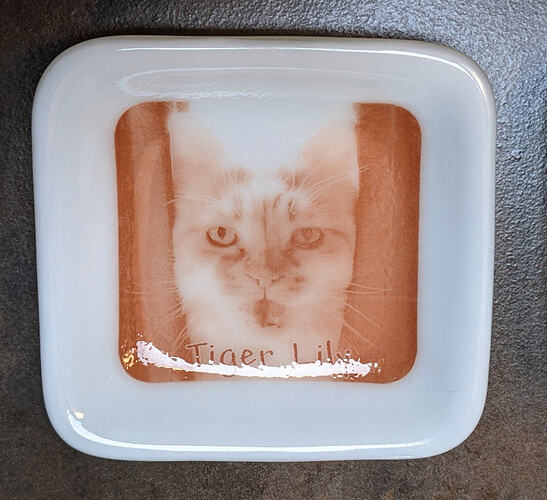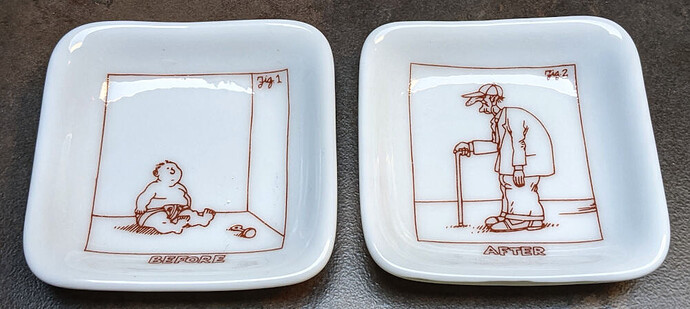Yup! It’s a chemical marking of the tile. If it’s done correctly you should be able to take a stainless steel object and not really cause any damage to the engraving without truly considerable effort. Solvents of any nature should be completely undamaging to the engraving.
Not the “new” method… but Norton white tile method using flat, white paint… works on picture frame glass as well. Here demonstrating the surface texture after engraving…
al bij een kunst(schilder) winkel geprobeerd?
Thank you for your responses. So this is more of an ‘embossing’ vs engraving. Are there substances other than titanium that produce a color finish?
I am currently unaware of any substances that will mark the tile in a similar way in a color other than black.
I think a better description is fusing a burnt metal onto the ceramic surface. That’s why it’s so impervious once it’s fused. The fusing process bonds the metal (titanium in this case, molybdenum if you’re using CRC DRY Moly. Not sure what’s used in Cermark) to the ceramic.
Thank you.
Yes, ‘fusing’ better describes it. Thank you.
this is a patent that Nokia has describing the marking of number pads using TiO2. It describes it as a photo chemical reaction, at least the white to black transition of the TiO2. The slightly embossed nature of the marking does suggest that there is material being fused to the surface of the tile though. GB2352824A - Laser markable material comprising TiO2 pigmented thermoplstic elastomer - Google Patents
I have heard that iron oxide produces a nice red color.
Interesting. I wonder if it also ‘fuses’ with the ceramic similar to TiO2?
Thks,
-B
Iron oxide (laser printer toner actually) fused on to glass in a kiln gives a nice red print.
No idea what it does on tile under a laser. Might need to experiment a bit with that.
I made an assortment of cat food plates a few years ago with various iron oxide images fired on.
EDIT: OK, I posted 2 images because I thought the other one showed how the process gave good line detail, but the art critics gave it a thumbs down as offensive so we’ll just go with this one.
Sorry.
Thank you @Hank, it was a great example so this was not an easy choice. But the content was a bit adult and we have a mixed crowd visiting. Thank you for understanding. 
That was my mistake. Sometimes I forget that not everyone here is an adult and that not all of the adults share my sense of humor. 
I’ve got a couple of other examples I can share after I wash some dishes.
Here’s 2 other plates that were done by firing black laser printer toner (which contains a lot of iron oxide) on to glass in a kiln.
I will order up some iron oxide to play with on tile under the laser.
Original artwork by B. Kliban.
Hank, How did you print the image on to the plate?
It’s printed onto a water-slide decal paper. That is applied to the glass, coated with a thin layer of clear glass frit then fired.
We’ve got a good local ceramics supply store that sells all kinds of chemicals to be used in glazes. I’m wondering what other chemicals might give a colored reaction on ceramic glazed tile under the laser?
I have always wondered if ceramic Fritz would work with a laser.
BTW just saw that some people are using zinc paint instead of white.
I may try the Chrome Oxide. I like the green color. Should be good for lizards and frogs ![]()
I placed an order a bit ago for titanium dioxide, black iron oxide, red iron oxide, black copper oxide, red copper oxide, and chrome oxide.
I have no idea what the difference between the red & black oxides is, but I guess I’m going to find out.


